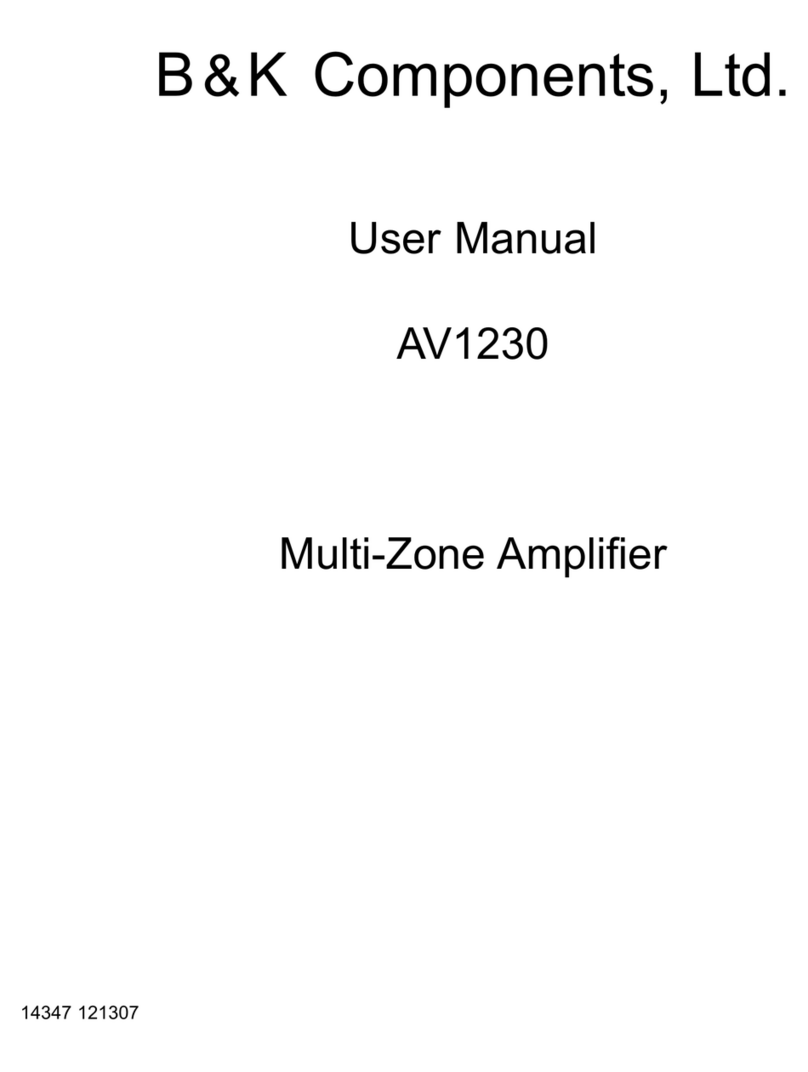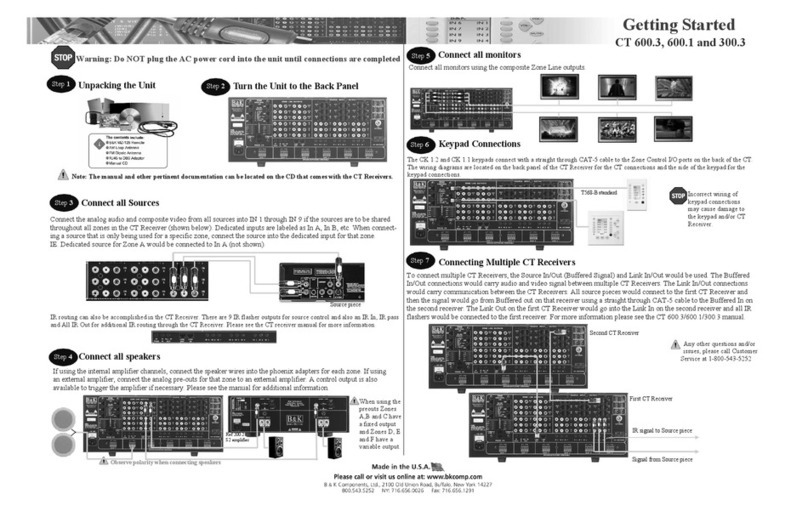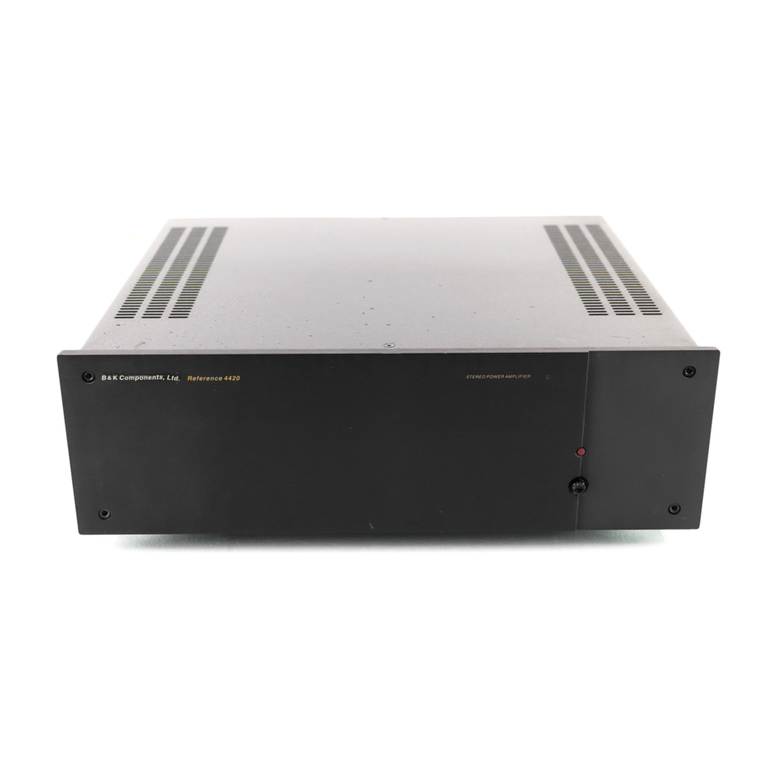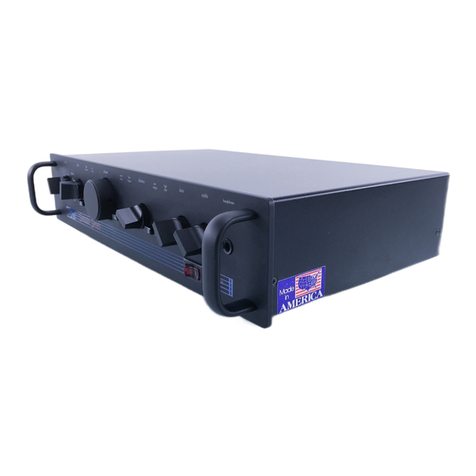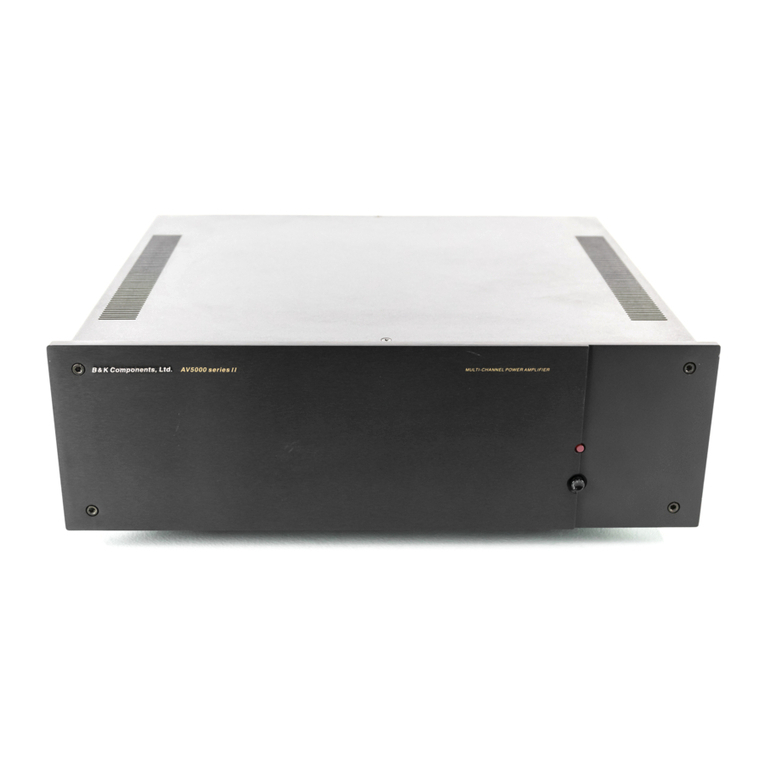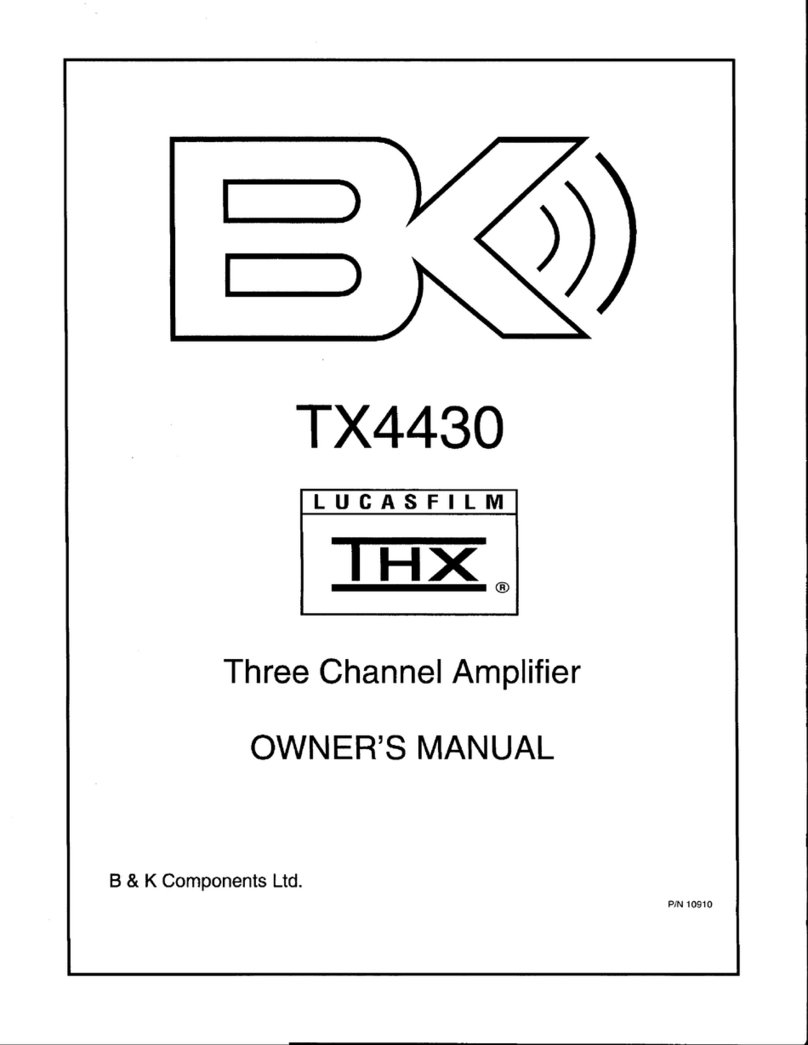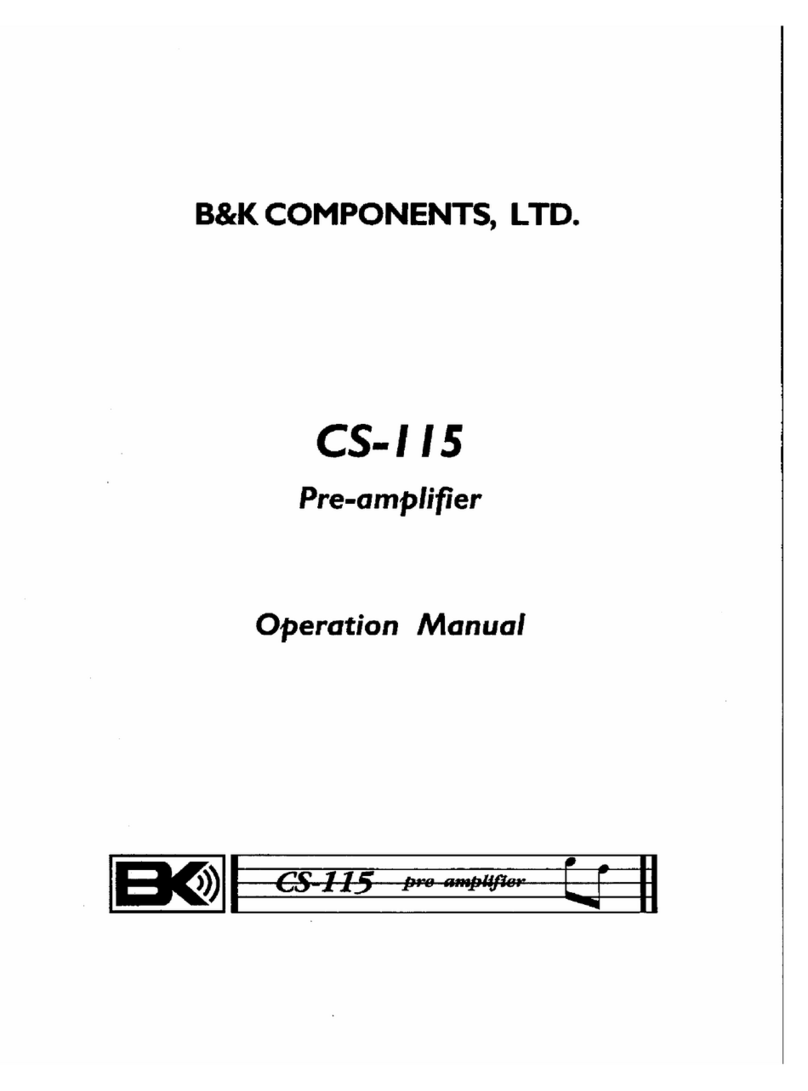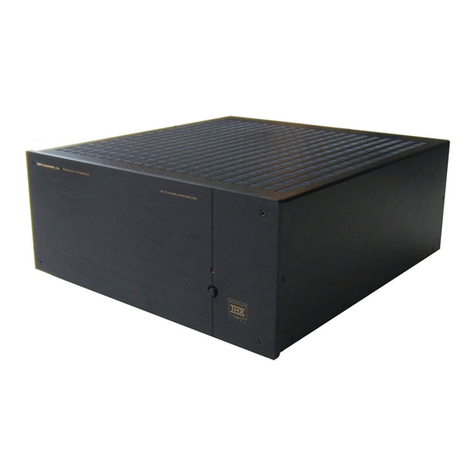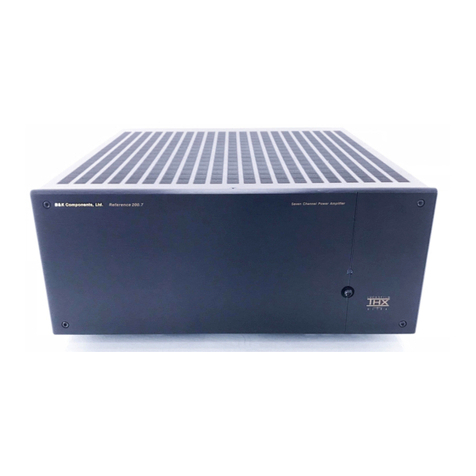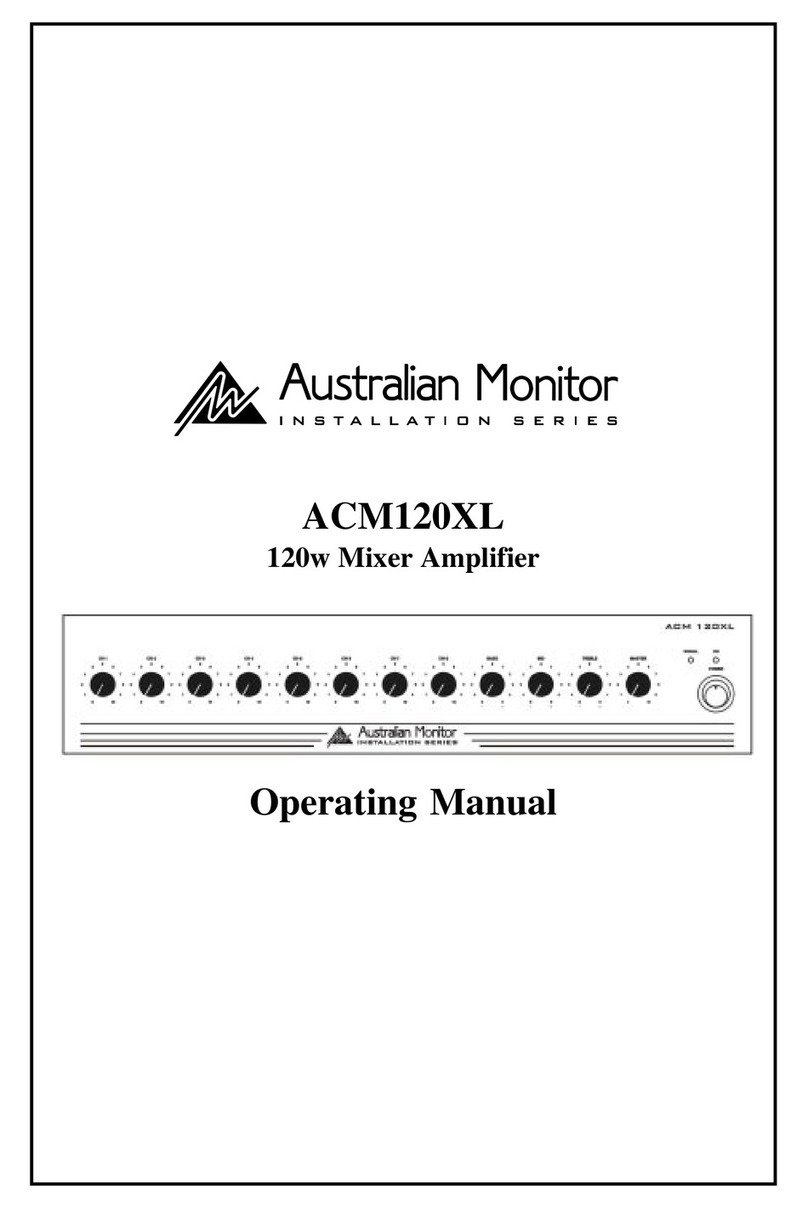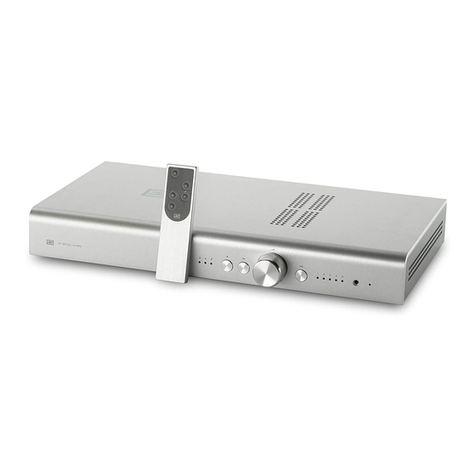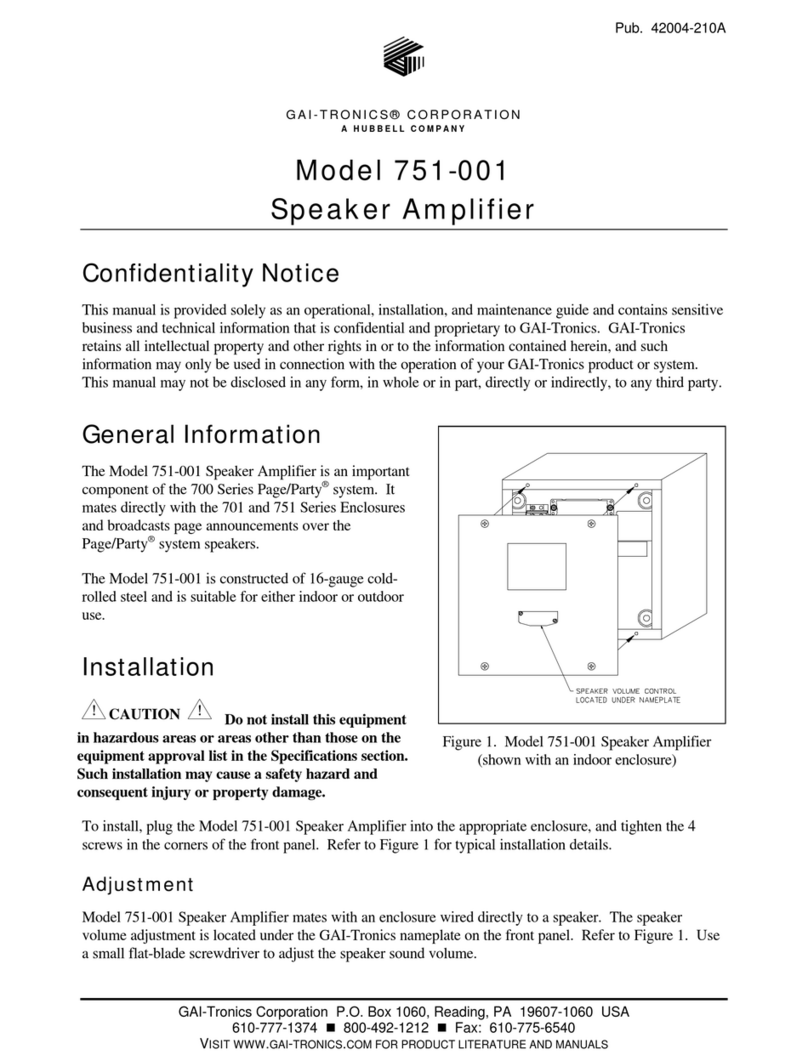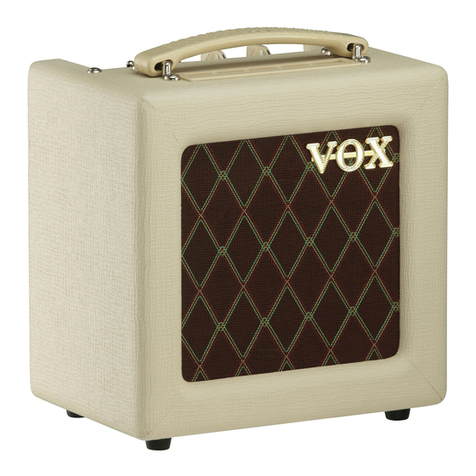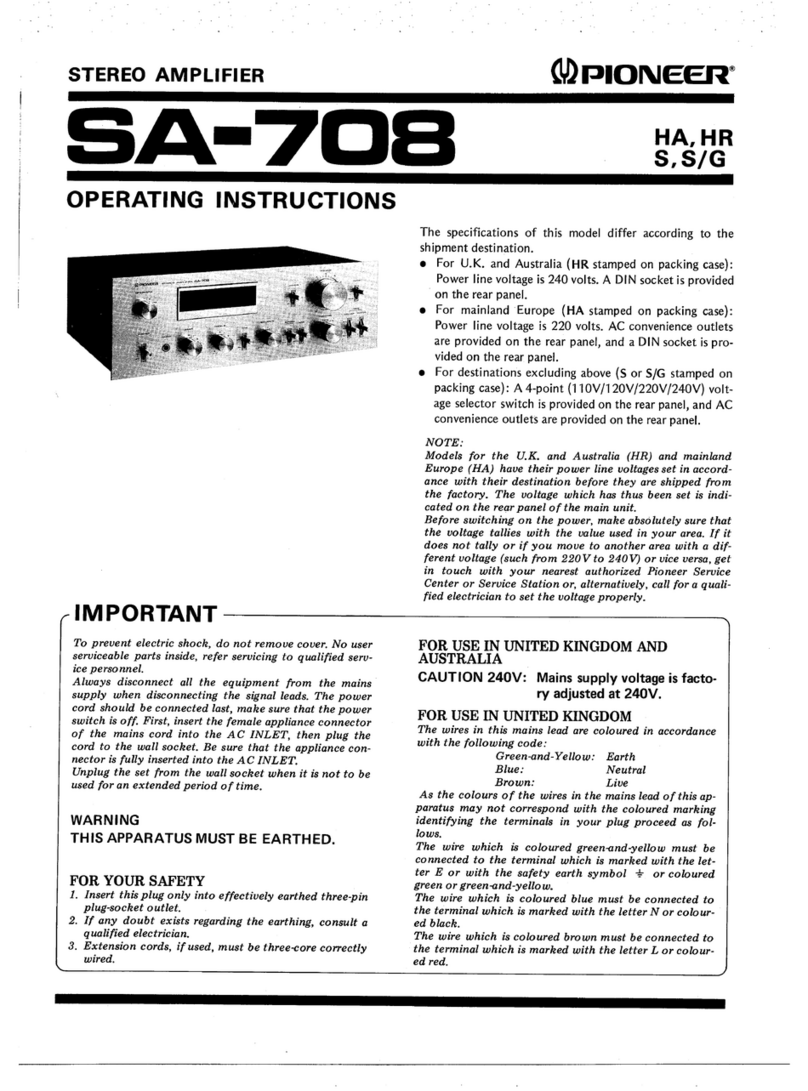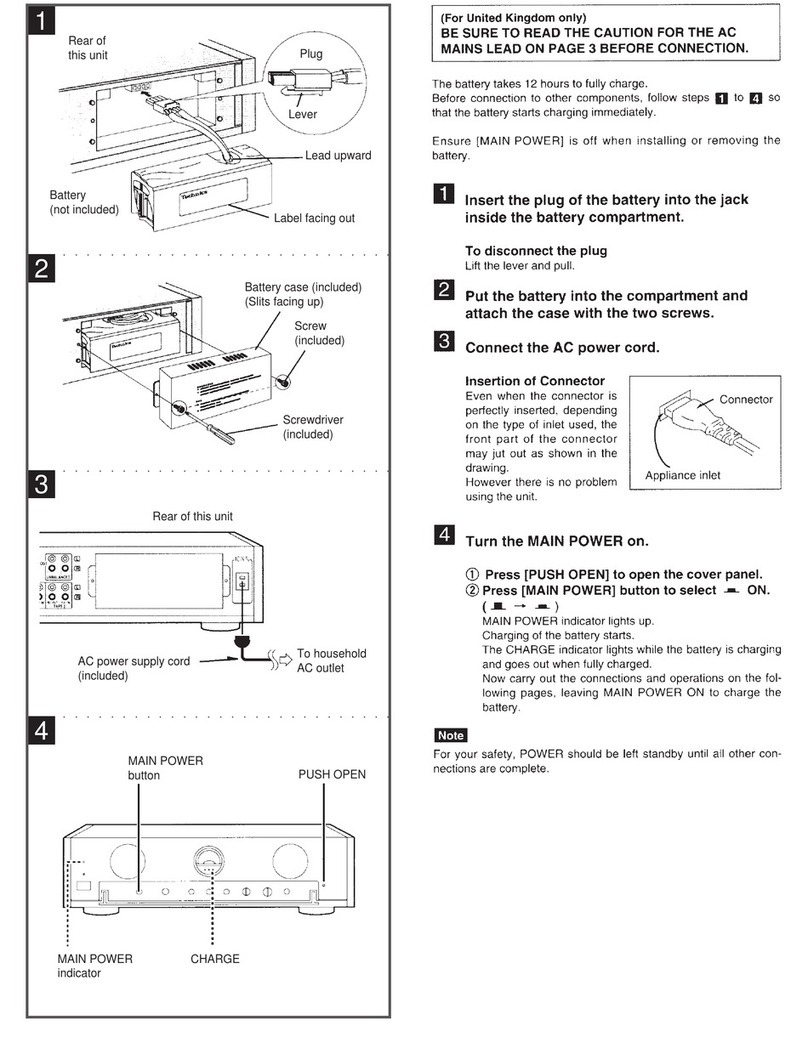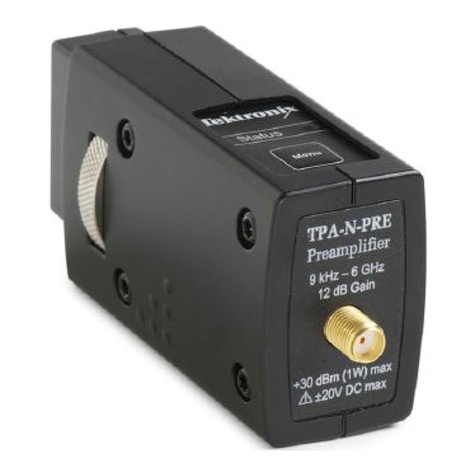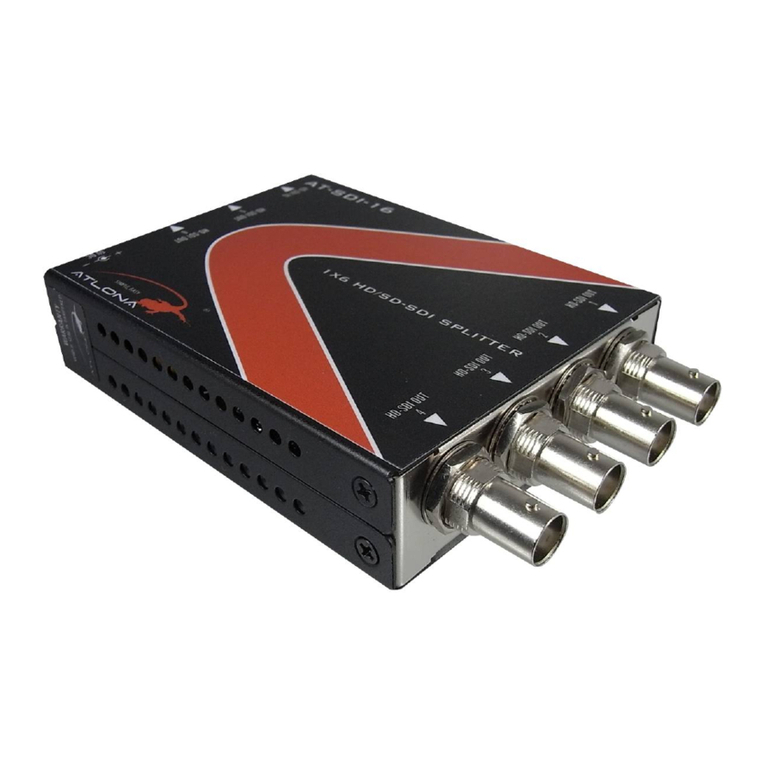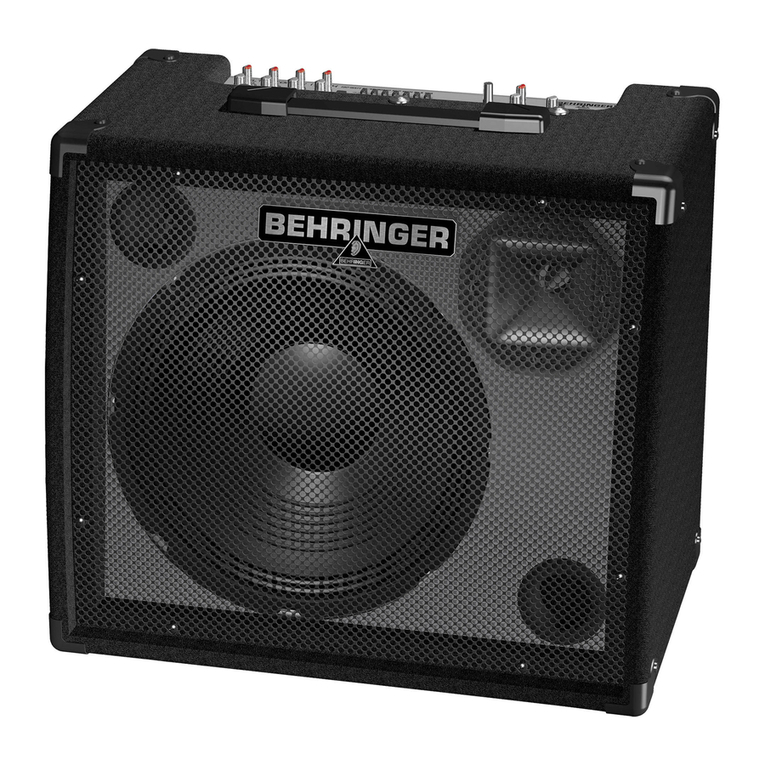B&K 2625 User guide

~
Goin
Adj
.
Olo20d8
l X
-40dB
X Z
Input
BrUel
&
Kjcer
CopoonhOgon
y
Go
in
Adj
.
-40to-20d8
v-·z-
·
Goln · Goin
Output
~
~
Vibration Pick-up Preamplifier
Type 2625
A fully transistorised preamplifier
of
modular design
for
vibration
measurements. Integration
networks
are included to give an output
proportional to acceleration, velocity,
or
displacement, from an accelero-
meter input. Fixed gains,
or
individually adjustable gains are
available from three separate inputs.


Vibration Pick-up Preamplifier
Type 2625
Reprint
february
1970

Contents
1.
Introduction . . . . . . . . . . . . . . . . . . . . . . . . . . . . . . . . . . . . . . . . . . . . . . . . . . . . . . 3
1.1. General . . . . . . . . . . . . . . . . . . . . . . . . . . . . . . . . . . . . . . . . . . . . . . . . . . . . . 3
2.
Description . . . . . . . . . . . . . . . . . . . . . . . . . . . . . . . . . . . . . . . . . . . . . . . . . . . . . . . 4
2.1.
Block
Diagram . . . . . . . . . . . . . . . . . . . . . . . . . . . . . . . .. . . . . . . . . . . . . . 4
2.2.
Front Panel . . . . . . . . . . . . . . . . . . . . . . . . . . . . . . . . . . . . . .. . . . . . . . . . . . 4
2.3.
Batt:ery Compartment
..........................
0
........
......
6
2.4.
Rear pane·l . . . . . . . . . . . . . . . . . . . . . . . . . . . . . . . . . . . . . . . . . . . . . . . . . . 6
2.5.
Module System
...............................
0.
..
0..........
6
2.6. Input Characteristics
....................
....
.....
.....
. . .
....
10
2.7.
Frequency Characteristics
........
0
•••••••••••••••••••••••••
0 0
11
2.8. Output Characteristics . . . . . . . . . . . . . . . . . . . . . . . . . . . . . . . . . . . . . . . . 12
2.9.
Sensitivity . . . . . . . . . . . . . . . . . . . . . . . . . . . . . . . . . . . . . . . . . . . . . . . . . . . 12
2.10. Distortion
...................................................
12
2.11. Noise
.......................................................
13
3.
Operation . .
........
...
.......
.......
................
0
•••••••••••
0 14
3.1.
Power Requirements
........
..................
..............
. 14
3.2.
Input and Output
.............................................
14
3.3. Integration Networks . . . . . . . . . . . . . . . . . . . . . . . . . . . . . . . . . . . . . . . . . 14
4.
Accessories . . .. . . . . . . . . . . . . . . . . . . . . . . . . . . . .. . . . . . . . . . . . . . . . . . . . . . . 15
5.
Specifications . . .. . . . . . . . . . . . . . . . . . . . . . . .. . . . . . . . . . . . . . . . . . . . . . .. . 17

1.
Introduction
1.1. General
The Vibration Pick-up Preamplifier Type
2625
is provided with integration
networks
for
measurement
of
velocity and displacement in addition to accelera-
tion. There are three input sockets connected to a selector switch, with in-
dividual sensitivity adjustment of each input. The two inputs not in use are
connected to ground. The function selector controls three different gain ranges
for
the three inputs: 1: Variable from
-40
to
-20
dB, 2: Variable from 0 to
+
20
dB, 3: Fixed at 0 dB. The integration networks are passive
RC
networks
with three different
lower
frequency limits.
1,
10
and
100Hz
for
velocity, and six
limits,
1,
3,
10,
30,
100 and 300 Hz
for
displacement measurements.
The output signal is taken from a standard microsocket 10-32 NF
or
a B& K
coaxial socket at the
front
panel,
or
from a microsocket at the back.
A field effect transistor stage in the
input
circuit
gives extremely high input
impedance, variable from about
3000
MQ at zero gain to about
450
MQ at
20
dB gain.
The preamplifier has a built-in battery compartment
for
battery operation or
may be powered by external source,
28
V
DC.
The Type
2625
Vibration Pick-up Preamplifier is a high
input
impedance
amplifier
for
use with piezoelectric accelerometers.
A piezoelectric device possesses a small capacitance, which develops a small
charge across
it
when subjected to an acceleration. If the accelerometer were
connected to a large capacitance, such as a long cable to an amplifier, the
sensitivity would be much reduced, because
of
the potential dividing action
of
the cable capacitance and accelerometer capacitance. The main function
of
the preamplifier is as an impedance transformer, between the high input
impedance required
for
the accelerometer, and low output impedance re-
quired
for
feeding the·signal into relatively high capacitance
of
a cable.
3

2.
Description
2.1.
Block
Diagram
A
block
diagram
of
the
circuit
is given in Fig.
2.1.
One
of
three inputs is selected by the selector switch, which also controls
the gain setting. The input stage is a field-effect transistor, and the main
amplifier stages are followed by the integration networks which are con-
trolled from the fro.nt panel.
Selector
Capacitive
Switch Attenuotor
Input
Stage
Differential
Output
Integration
Amplifier
Stage
Networks
Feedback
Adjustement
Power
Amplifier
Fig. 2.1.
Block
diagram
of
preamplifier
circuit.
2.2.
Front Panel
The front panel
of
the 2625 is shown in Fig. 2.2. The controls are as follows:
ACCELERATION, VELOCITY, DISPLACEMENT. This knob selects the integra-
tion networks. In the ACCELERATION position no integrating networks are
connected. Three velocity and six displacement positions are possible, giving
lower limiting frequencies as indicated. The low frequency
limit
should be set
as high as possible to obtain the best possible signal to noise ratio.
INPUT SELECTOR. This knob has twelve positions, and selects which
of
the
3 inputs,
X,
Y
or
Z is used. The two inputs
not
in use are connected to
ground.
Three
of
the twelve switch positions are labelled
X
y
z Gain Adj.
0--20
dB
whereby the gain
of
the amplifier can be adjusted individually between 0 and
20
dB
for
the three inputs. Thus
it
is possible to scale the signals from three
different accelerometers
or
from a triaxial accelerometer to the same value
4

Fig.
2.2.
Front panel
of
the preamplifier.
of mV/g for each channel. Accelerometers with sensitivities from 1 to
10
mV/g
can be scaled to 10 mV/g and those with sensitivities from 10 to
100
mV/g
can be scaled to 100 mV/g.
Also in the input stages is a capacitive attenuator which gives
40
dB attenua-
tion. This gives six more switch positions, labelled
X
y
z Gain Adj.
-40
to-
20 dB
5

and X
Y
-40
dB
z
giving the possibility
of
adjusting the gain between
-40
and
-20
dB
or
giving
a fixed gain
of
-40 dB.
The remaining three positions
of
the selector switch are labelled
X
Y 0 dB
z
in which no sensitivity adjustment is possible.
GAIN. These three potentiometers are used
for
adjusting
the
sensitivity in-
dividually for the three inputs, as described under INPUT SELECTOR.
INPUT. The three input sockets require miniature coaxial plugs Type JP 0012,
for connection to the accelerometer via mininoise cable. The two inputs not
in use are always grounded.
OUTPUT. There are two output sockets available on the front panel, electrically
identical. One is a standard microsocket, the
other
a B &K coaxial socket.
GROUND. The small unmarked terminal is connected to the instrument chassis.
2.3. Battery Compartment
Batteries
for
the
instruments internal supply are kept in the
top
compartment
shown in Fig. 2.3. The compartment is accessible by removing the
top
screw
on the rear
of
the
equipment (Fig. 2.4), and sliding the top panel backwards.
3 X 9 V batteries are required, size 25.5 X 48.5 mm. (IEC Recommendation
86-2.6
F 22). See specifications.
2.4. Rear Panel
The rear panel
of
the instrument is shown in Fig. 2.4.
POWER SWITCH. This connects the power to the instrument by selecting either
the internal batteries
or
the external supplies. Four positions are available and
are labelled OFF. BATT. EXT. POWER and ZR 0024, respectively. In position
ZR
0024 the output is switched from the power amplifier to the integration net-
works, thus reducing the power requirement from + 28
V.
7
rnA
to + 28
V.
2 mA.
+ 28
V.
External power, including that from the ZR 0024 is supplied to this
microsocket (centre pin positive).
OUTPUT. This is the third output socket and is electrically identical to the two
on the front panel.
2.5.
Module System
The preamplifier is part
of
the B &K module system
of
instrumentation as
shown in Fig. 2.5. This system makes rack mounting
of
instrument combinations
very convenient.
6

•
Fig. 2.
3.
Battery compartment.
Fig. 2.4. Rear
panel
of
the
preamplifier.
A one
tier
system contains the required combination
of
modules mounted in
the metal case KK
0010.
This again fits into the wooden case KA
0020,
making
a portable instrument system. Standard 19" rack mounting is simple, using
the rack mounting lugs which are screwed onto the case KK
0010.
A three
tier
system is made up
of
three metal cases KK
0010
containing the
required modular instruments, all mounted in the metal case KK
0011.
This
assembly again fits into the wooden case KA
0020.
7

•
Fig.
2.5.
The 8 & K module system.
8

2500
2000
1500
1000
500
0
"'
•
Fig. 2.6. Mounting
of
module.
Input Resistance
2 4 6 8
10
12 14
16
18
20
dB
---:J•~
Gain
.;?~7/....fL7
Fig. 2.7. Input impedance as a function
of
gain setting.
9

The modules are mounted in the metal cases KK 0010 and KK
0011
as follows:
1.
Loosen the finger screw in the front plate
of
the module and slide out
the bottom plate.
2. Unscrew the feet from the bottom plate.
3.
Using the same screws, fix the bottom plate inside the case KK
0010.
4.
Slide the module on to the bottom plate and fix it with the finger screw.
2.6. Input Characteristics
Input Impedance
This is very high because of the field-effect transistor input, but it does vary
with the gain setting, as shown in Fig. 2.7. If the input is fed from a source
capacity of c., and the input resistance is R'
"'
this will give a lower limiting
frequency,
t,
of
~
nC.R,
".
At
20 dB gain with a source capacity
of
1000
pF,
this gives f =
0.3
Hz.
Hence for low frequency measurements it may be
an
advantage to set the gain to 0 dB.
Input Capacitance 14
pF.
0
dB
- 2
-4
-6
-8
-10
1---
0.01Hz
/
-
OdB
,L
~
10dB
/ I
/
-
--
_,......,.
/ , /
~dB
-
V2
odB
/
/
/
0.1Hz
/
-
-/
-20dB
1Hz
I I
I
I
............
" '
!'\. "
'\.
'
I '\.
'\.
I
II
II
II
100kHz
OdB
20...,
OdB
20dB
I I I_
-1~F
1
L~d
1
_
I I
I!
-150pFLood1
I I
Ill
I I I l l
I I
Ill
1000kHz
2~
7/#
.9
Fig. 2.8.
Amplifier
frequency characteristics.
~
t:=:::
!--....
r:
~
:--
~
.
'\
~'
I'
dB
10
""'
~
~
'\.
20
~
30
40
50
1Hz
~
"
~
~ '
1\.
~
\
1\
t-\
t=:::
r--..
~
~~
~
"'
.
'\
~'r--..
1'\
~
~~
~
~~
~
~'
~
"
~
""
~
~
!"'
~
\
I\
~
10Hz
\
~
.'i
'\.
~
~l'\.
~
~~
~
~
1'\.
1-Z
'!'-....~
~
"'~
\
~
~
100Hz
II
II
11:
1~z
_I
3~/~~
.1
Velocity 2:
10Hz
-
0
.
3m~ec.
3:
100Hz
-0
.
03m
sec
.
Displacement 4:
1Hz
-1000mm.
~
~
~
~
~'
"-....
1kHz
5:
3Hz
-
100mm.
6:
11Hz
-
10mm
.
7: 30Hz -1mrn.
8:
100Hz-
0.
1mm
.
9;DJHz -
0.01mm
.
'"-
\
~
--
"-.....
"I'
10kHz
L
~
7'/#'
Fig. 2.9. Frequency response
of
integrating
networks.
10

10,-
--
--------.-
--
--------
.-----------.-------
-----
5~----------~--~--~--~--~--~--~~~-------
()ut
\l:lltage
CRMS)
2
1----
--------l-----
--~--~--~.._-~.-----P-.:--____;~~.._---j
Limit
for
negligible
distortion.
1--
----------!-----------h-
--"""
------>..
;:--
...P.,,----~--~.._---j
0 dB gain setting
Frequency Hz
Fig. 2.10.
Limit
of
high frequency response
due
to
capacitive
loading
in
position
"ACCEL."
without
power
amplifier.
10
Output
Voltage
(RMS)
2
0.1
0.
01
~
10
10
2 5
10
3
A
1~
"' "'
" "
""
"
5 10'
Freoqueoncy
Hz
~
10'
Limit
for
negligible
distortion
0
dB
gain
setting
Fig.
2.11.
Limit
of
high frequency response due to
capacitive
loading
of
power
amplifier
.
Maximum Input Signal ± 0.7 V
at
20
dB
gain
± 7 V
at
0
dB
gain
±
70
Vat
-20
dB
gain
±
700
V
at
-40
dB
gain
11

2.
7.
Frequency Characteristics
The frequency characteristics
of
the amplifier in the acceleration mode (no
integration) are given in Fig.
2.8.
The frequency response
of
the
integration
networks are given in Fig.
2.9.
2.8. Output Characteristics
When the preamplifier is operated from the ZR
0024
the maximum output voltage
and current available in position ACCEL. is ± 7 V ± 1
rnA
peak. In VELOCITY
or
Displacement positions the minimum Load impedance
is
1 MQ. This limits
the high frequency performance when working into capacitive loads, as Fig.
2.10 illustrates. However, when BATT.
or
EXT.
POWER are·selected, the output
is taken from the
power
amplifier. In these positions the maximum output
voltage and
current
is ± 7 V ±
2.3
rnA
thus reducing the loading restriction
considerably as shown in Fig.
2.11
.
2.9. Sensitivity
As explained
under
INPUT SELECTOR there are fixed gains
of
0 dB and
-
40
dB, and variable gains from 0 to -
40
dB available. The voltage sen-
sitivity
of
B &K
acce
·lerometers, with cable, is given in the calibration chart
supplied with unit.
If
a
different
cable is used, the sensitivity is changed, and
becomes
where
Sv
is
the
calibrated sensitivity
12
OJo
C1
is
the
accelerometer
capacitance (without cable)
c.
is
the
cable
capacitance
used when
Sv
was measured
C.1
is
the
new cable capacitance
Distortion
5 (28V Power Supply}
3
2
2nd.
harmonic
--
3rd. harmonic
---
o~--~--~--~~~~~~---r=-~--+---~-4~
0 1 2 3 4 5 6 7 8 9 10V
RMS
Output Voltage
..;?6"7/~-o
Fig. 2.12.
Distortion
for 0 dB
and
20
dB gain.

2.1
0.
Distortion
Distortion originating in the preamplifier is shown in Fig. 2.12,
for
0 dB and
20
dB gain setting.
2.11. Noise
The noise spectrum from
20
Hz
to
40
kHz, in 1/3 octave steps, is shown
in Fig.
2.13.
Total noise in the range
20
Hz
to
40
kHz appears at the right hand end
of
the
scale, marked
"Lin.".
Total noise when weighting networks A,
B,
C are em-
ployed also appear here.
.
ooooooooccccccoooooooocoooooooooooocooooocooooooo
lri:.!!!J•r+aoa
--~
..
Aeceleratton
mode
0
dB
gain
0.
1mV
full scole
10
15
......
__
_
....
__
_
...,
__
_
-
---
......
___
,.,
~-
,
~
,_..,
__
_
~'-',.."'
•-
oo
OP1123
10
1lO
-ria
CIIIDIIA I
CU.
,
..
, . , , • c
u..
'"'
Fig. 2.13. Inherent noise
spectrum
(1/3 octaves).
13

3.
Operation
3.1.
Power Requirements
3 X 9 V
batteries
for
the
internal
supply
are fitted into the
instruments
top
com-
partment using the
three
push stud connectors as described in Section
2.
The
external + 28 V 7 rnA
supply
is connected to the
microsocket
at
the rear
of
the equipment, as is the ZR 0024 which supplies +
28
V 2 mA from B &K
instrument
Types 2107/
12,
2603/
06
and
2801
/
03.
Connection is made via a
JP
0012 plug, available from B & K (see Accessories).
3.2.
Input and Output
The
three
inputs
require
miniature
coaxial plugs type
JP
0012
for
connection
via cables
to
the
accelerometer.
A ready made cable
is
supplied
with
each
B &K
accelerometer.
The
output
is taken from one
of
three
electrically
identical
sockets. One
at
the
rear and one on the front
are
miniature,
requiring
plug
type
JP
0012. The large
socket
on the
front
panel takes
the
B &K coaxial
plug type
JP
0018,
one
of
which
is supplied with the amplifier.
If
the
cables
to
the
input
are changed, it must be noted
that
the sensitivity
will
change, as
mentioned
in section
2.9.
Long cables on the
output
will also
affect
the
high
frequency
response, as shown in the curves
of
Fig. 2.9 and
2.10.
Note
that
since
the
outputs
are
directly
coupled,
it
may be necessary to
block
or
balance
out
the
standing
DC voltage
(...n...
13
V)
present
at
these sockets.
3.3.
Integration Networks
When using
the
integration
networks, Fig. 2.9 should be consulted, to ensure
that
the
network
selector
switch
is in the
correct
position
for
the
frequency
range
of
the
signal. The best possible signal to noise ratio is obtained by
setting
the
low
frequency
limit
as high as possible. (The
low
frequency
limit
is marked on the
front
panel).
14
To
calibrate
the
amplifier
and accelerometer with the
integration
networks:
1.
Switch
to
position
"Accel."
.
2.
Vibrate
accelerometer
at
10 mj sec2
(1
g).
3.
Note
deflection
V (volts) on indicating instrument
connected
to
output
of
amplifier.
If possible,
adjust
this to some convenient
fraction
of
full
scale
deflection,
for
instance
with the adjustable
gain
facility
on the
amplifier.
4.
An
output
voltage
of
V volts with the network
selector
switch
at
a
velocity
or
displacement
position now means that
the
velocity
or
dis-
placement
is
the
value
marked on the
front
panel.

4.
Accessories
The following accessories are available for acce·lerometers and preamplifiers.
UA 0125 Set of studs containing
10
isolated studs YS
0420,
10 steel
studs
YQ
2960,
10
nuts YM
0414,
10 mica washers
YO
0534,
1 die and 1 tap NF 10-32.
UA 0142 1 set of clamping magnets containing 5 permanent magnets
UA
0070
with isolated mounting.
UA 0129 Set of
20
mini~ture
plugs
JP
0012
with tools and instruction
for mounting of the plugs on cable.
UA 0130
1.2
m (4 ft.) of mininoise cable
for
operation to 100°C (212°F)
fitted with miniature plugs. Individually calibrated.
AO 0038
1.2
m
(4
ft.) of mininoise cable
for
operation to 260°C (500°F)
fitted with miniature plugs. Individually calibrated.
AC 0010 Mininoise cable up to
600ft.
in one length.
90
pF/m
or
30
pF/ft., for operation to 100°C (212°F).
AC 0005 Mininoise cable up to 600 ft. in one length.
90
pF/m
or
30
pF
/ft.,
for
operation
to
260°C (500°F).
Fig. 4.1. Photograph
of
UA
0129
and
instructions for mounting
of
the plug
JP 0012.
15

-
oiit•r
.svrt'aceot'
c•ntr:e·-insulation
isgra;Miteciiatea.
Clea
!!__~
x"osed
insulatiOilto
l'r•vent
-
leakage
16

Input
Resistance:
Input
Capacitance:
Frequency Range:
Max.
Input
Signal:
Gain:
Noise:
Load Impedance:
Output:
Harmonic
Distortion:
Power Supply:
Batteries:
Current
Consumption:
5.
Specifications
Varies from 450
MQ
at
20
dB
gain
to
3000 MQ
at
"0
dB".
14 pF.
Ace.
Vel. 3.16
m/sec
» 0.316 »
))
0.0316
))
Displ. 1000 mm
))
100
))
10
1
))
0.1
))
»
0.01
))
± 7 V
at
0
dB
gain
± 700 V
at
-40
dB
± 0.7 V
at
20
dB
gain
± 70 V
at
-20
dB
Fixed 0 and
-40
dB.
1
Hz-
35kHz
1
Hz-
4kHz
10Hz-
10 kHz
100
Hz-
30 kHz
1
Hz-
30 Hz
3Hz-
100 Hz
10Hz-
300Hz
30Hz-
1000 Hz
100
Hz-
3000 Hz
300 Hz
-10000
Hz
Variable 0
to
20
dB
and -40
to
-20 dB.
Max.
20
11-V
from
2 Hz -40 kHz with 1 nF across
input
(referred
to
input).
Integration
Networks:
Min. 1 MQ, max. 150
pF
·(in
position ZR 0024).
Power Amplifier. Min. 3 kQ.
Max. ± 7 V peak, 13 V DC.
Output
impedance
<30 Q.
Less than 1 %
with
5 V RMS
input
at 0 dB, accelera-
tion.
External
28
V
DC
source
(for
example ZR 0024)
or
internal 3 X 9 V
batteries
(not
included).
3 X 9
V.
IEC
Recommendation
86-2, 6 F
22,
size
25.5 X 17.5 X 48.5 mm.
Approximately
2 rnA in
position
ZR
0024.
Approximately
7 rnA in
position
BATT.
or
EXT.
POWER. Internal
battery
life
..J\..
7 hours.
17

Examples:
Dimensions:
Weight:
Accessories Included:
18
Manufacturer I Type
Union Carbide Ever Ready No. 216
Hellesen Type H 10
Varta Pertrix No.
438
Tudor
No.4
T4
National
U-006P
(excluding knobs and feet):
Height: 132.6 mm
(5.22
ins.)
Width:
61
mm (2.40 ins.)
Depth: 200 mm (7.87 ins.)
820 g (1.8 lb.)
Two
cables AO 0037, 1.2 m
(4
ft.) long.
One coaxial plug JP
0101.
Table of contents
Other B&K Amplifier manuals

B&K
B&K Reference 3220 User manual

B&K
B&K ST140M User manual

B&K
B&K ST1430 Series II User manual
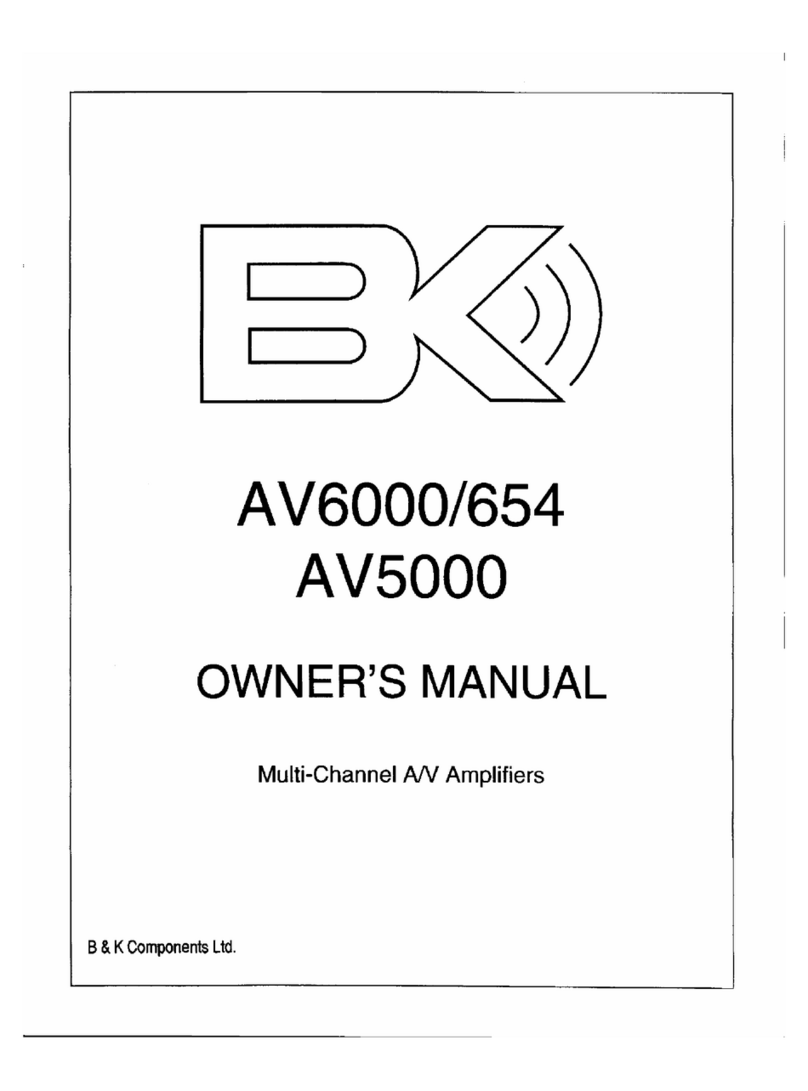
B&K
B&K AV6000/654 User manual
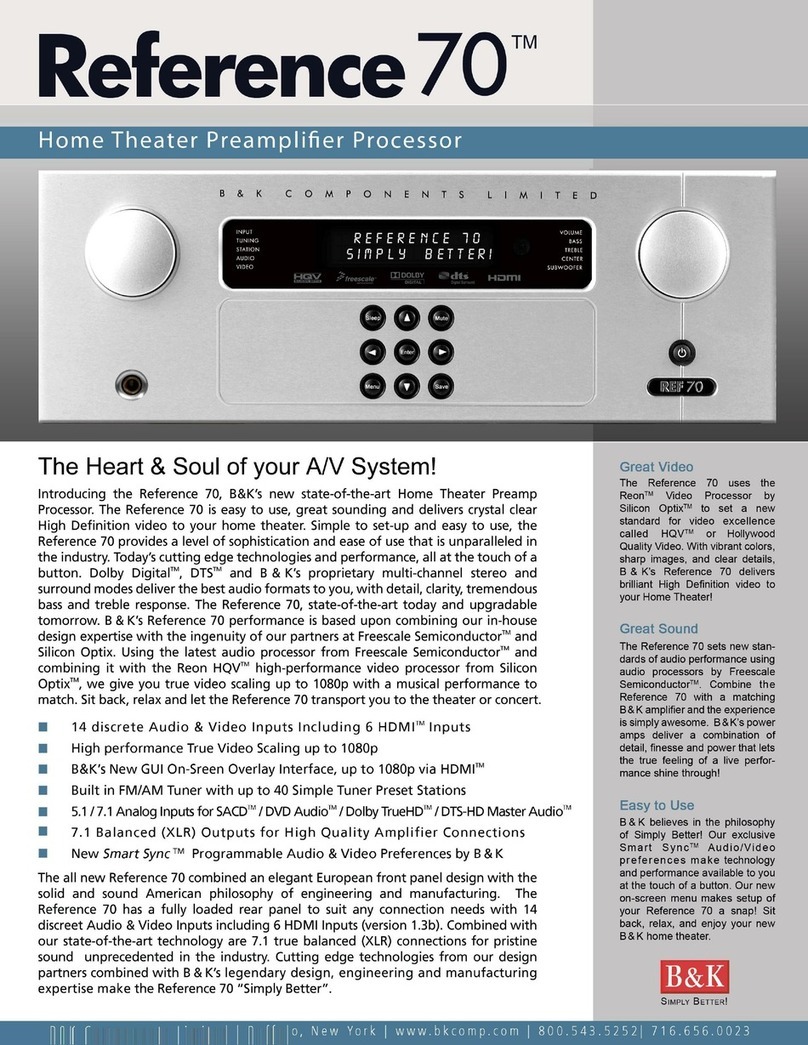
B&K
B&K Reference 70 User manual
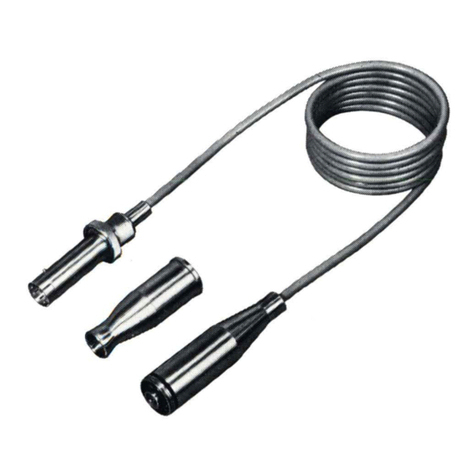
B&K
B&K 2627 User guide
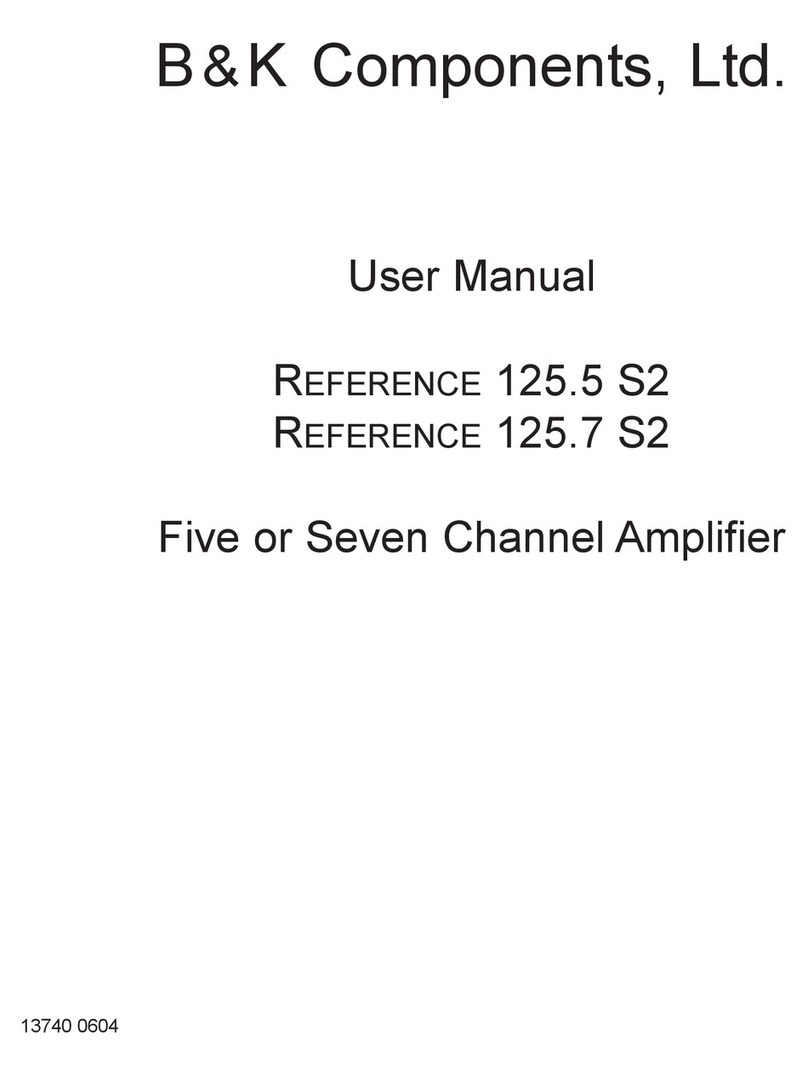
B&K
B&K FIVE OR SEVEN CHANNEL 125.5 S2 User manual

B&K
B&K Reference 70 HT 70 User manual

B&K
B&K AV6000 Series II User manual
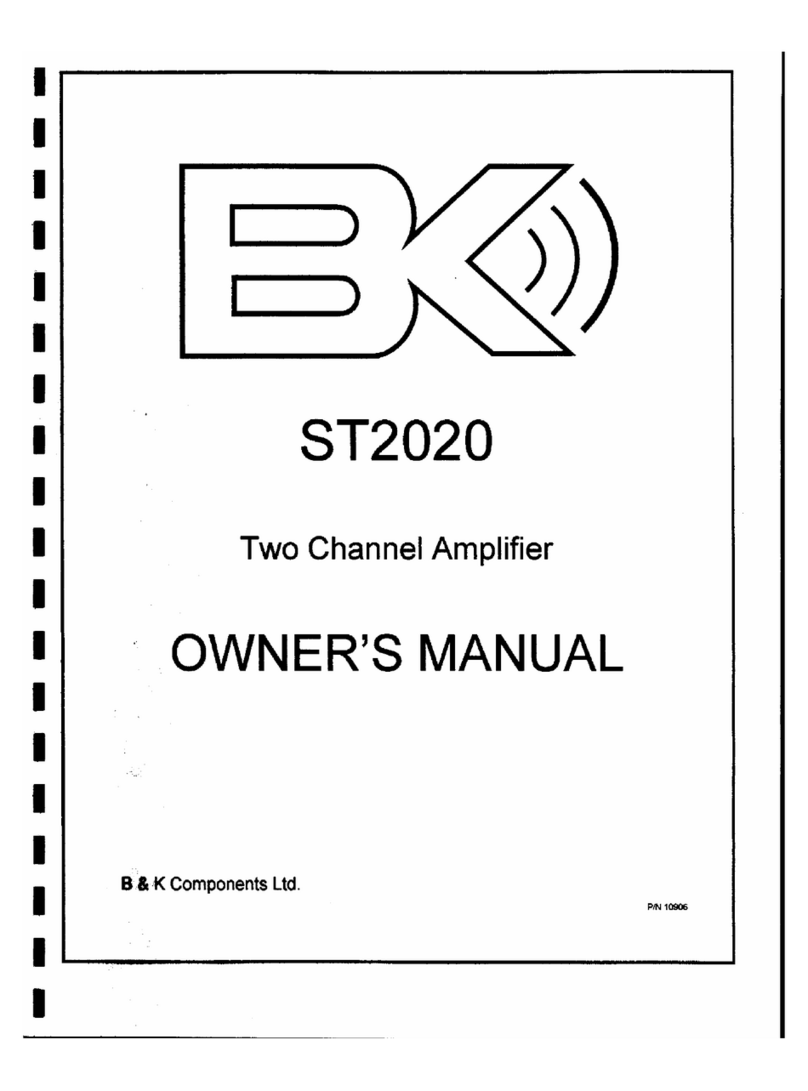
B&K
B&K ST2020 User manual
